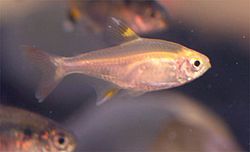| Tetra | |
|---|---|
 | |
| Ornate tetra, Hyphessobrycon bentosi | |
| Scientific classification | |
| Kingdom: | Animalia |
| Phylum: | Chordata |
| Class: | Actinopterygii |
| (unranked): | Otophysi |
| Order: | Characiformes |
| Genera | |
More than 150 [1] | |
| Groups included | |




Tetra is the common name of many small freshwater characiform fishes. Tetras come from Africa, Central America, and South America, belonging to the biological families Characidae, Alestidae (the "African tetras"), Lepidarchidae, Lebiasinidae, Acestrorhynchidae, Stevardiidae, and Acestrorhamphidae. In the past, all of these families were placed in the Characidae. [2] [3] The Characidae and their allies are distinguished from other fish by the presence of a small adipose fin between the dorsal and caudal fins. Many of these, such as the neon tetra (Paracheirodon innesi), are brightly colored and easy to keep in captivity. Consequently, they are extremely popular for home aquaria.
Tetra is no longer a taxonomic, phylogenetic term. It is short for Tetragonopterus , a genus name formerly applied to many of these fish, which is Greek for "square-finned" (literally, four-sided-wing).
Because of the popularity of tetras in the fishkeeping hobby, many unrelated fish are commonly known as tetras, including species from different families. Even vastly different fish may be called tetras. For example, payara (Hydrolycus scomberoides) is occasionally known as the "sabretooth tetra" or "vampire tetra".
Tetras generally have compressed (sometimes deep), fusiform bodies and are typically identifiable by their fins. They ordinarily possess a homocercal caudal fin (a twin-lobed, or forked, tail fin whose upper and lower lobes are of equal size) and a tall dorsal fin characterized by a short connection to the fish's body. [4] Additionally, tetras possess a long anal fin stretching from a position just posterior of the dorsal fin and ending on the ventral caudal peduncle, and a small, fleshy adipose fin located dorsally between the dorsal and caudal fins. This adipose fin represents the fourth unpaired fin on the fish (the four unpaired fins are the caudal fin, dorsal fin, anal fin, and adipose fin), lending to the name tetra, which is Greek for four. [4] While this adipose fin is generally considered the distinguishing feature, some tetras (such as the emperor tetras, Nematobrycon palmeri ) lack this appendage. Ichthyologists debate the function of the adipose fin, doubting its role in swimming due to its small size and lack of stiffening rays or spines. [5]
Although the list below is sorted by common name, in a number of cases, the common name is applied to different species. Since the aquarium trade may use a different name for the same species, advanced aquarists tend to use scientific names for the less-common tetras. The list below is incomplete.